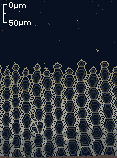17 Mirnacel
Name: Mirnacel
Ancestor: Hexastacel
Description: This is amongst the first multicellular organisms on planet Oxidi. The rock-bound cells are reliant on the rock, and each cell up the stack is reliant on the one below it as well as the rock. New cells grow up the stack and from vacant side-faces from the rock-bound cells. Cells grow fused together, intended to never separate except during necrosis. Some organelles (including copies of the genome complex) travel throughout the organism from cell to cell via metallic thread tracks, a zip-line-like network that provide structure and act as a conduit for cell operations. Thus the organism acts like a giant cell in some ways. However in other ways it acts as a multicellular organism, with controlled cell differentiation occuring in patterns of growth and distribution. Simplified example: For every seven downward electron transfer stack along, grow one slightly wider upward electron expulsion stack (and for respiratory waste), repeat.
If cell death occurs in the layers beneath, controlled corrosive necrosis occurs up the cell stack to allow the escape of debris and fragments so that new growth can take it's place. Cells are much more robust than their ancestors and beneath cells are both fed and necessary for the electron transfer chain, so they don't form a composted layer beneath them and don't have any decomposers living amongst them.
It exists on the extreme fringes of what is possible for any kind of their protein or RNA structure to exist with the complementary molecular accessories to protect their organelles and matrices from thermal degradation. A few of these complementary molecular accessories (many made of carbon and metal) have themselves taken on an information storage function because they are resistant to high temperatures, reducing a cell's reliance on the much more thermally sensitive RNA, lipids and proteins. This new form of genetic material will for now be called "metallic inverse rhibonucleic acid" or "MIRNA". The geometric crystalline structure of the organism is very compact and strong to resist the strong heat-fueled vibrations at these temperatures affecting the overall molecular stability of pretty much everything.
Extreme thermal changes would not be needed to fuel reactions in these cells the same as they're needed in their cousins the turbifluxus. They can survive on consistent intense heat, being more heat-resistant. The structure of the organism as well as it's environment allows the free movement of electrons, driving reactions across the naturally forming gradients in electrical charge between the searing hot rock they live on and the high pressure beyond boiling acid water in their external environment. They effectively remain perpetually charged on a natrual battery that they themselves are a component of. Some cell stacks guide electrons downwards, while some allow electrons back up to near the surface. This is a mixed process comprised of some conduction along metallic material and of some metabolic reactions.
Reproduction: The budding cells at the top of cell stacks release from the point of growth easily and regrow quickly, being sent to other parts of the hydrothermal system or out into the open ocean. At low temperatures these budding cells remain dormant metabolically.
Optimal ambient temperature: 310°C
Regions: Deep hydrothermal vents
Remove these ads. Join the Worldbuilders Guild









Comments